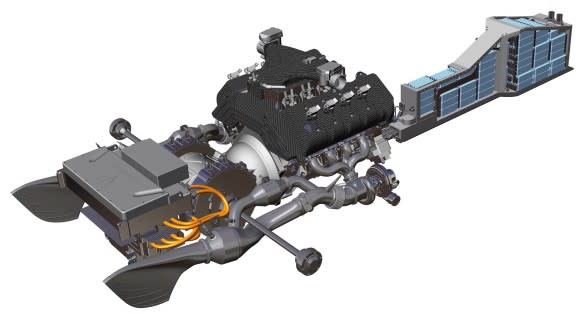Koenigsegg Regera Supercar: A New Configuration For Plug-In Hybrids?
Hybrid powertrains used to always tag vehicles as optimized for fuel efficiency.
But that’s changed in very pronounced ways the past several years, as the fastest supercars in the world--from McLaren, Ferrari, and Porsche--have all adopted some form of hybrid technology that helps with acceleration and performance.
ALSO SEE: Kids React To Tesla Model S P85D 'Insane' Mode Launch: Video Shows How Fast It Is
And increasingly, with models like the McLaren P1 and Porsche 918, automakers are showing how wealthy owners can stay electric-only and free of tailpipe emissions for lower-speed use in urban city centers, saving the zany acceleration times for the racetrack and the countryside.
The latest to go hybrid is the Swedish supercar maker Koenigsegg. For the Koenigsegg Regera, shown first earlier this month at the Geneva Motor Show, its claims include acceleration from a standstill to 186 mph in 12.3 seconds, and to 249 in less than 20 seconds. Top speed? It’s claimed at a blistering 255 mph.
All those numbers would beat the Bugatti Veyron, as well as both the LaFerrari and the 918 Spyder, by the way.
But before you tune out completely—because this is Green Car Reports, after all—we thought that Koenigsegg is worth a closer look as they’ve joined the hybrid group in a novel way—by ditching the gearbox altogether. And there’s potential with such a system to produce an interesting kind of plug-in hybrid, EV mode and all.

All-electric at startup
In the Regera, the gasoline engine, a twin-turbo V-8, is clutched in by a viscous clutch pack—a “torque conversion device” as Koenigsegg development chief Jon Gunner called it while explaining the system to us.
It’s not all that different than the systems that send variable amounts of torque to the rear wheels in many all-wheel drive systems, but it allows a unique setup, with the electric motors used to their potential, from a standing start, and the gasoline engine geared tall and thus not clutched in until 20 or 30 mph.
“Then the engine is at about 600 rpm; we usually have absolutely no power, but given that you have the 400 N-m, plus 80 N-m from the gasoline engine,” explained Christian von Koenigsegg, the company’s founder and the technical visionary behind this powertrain, at the company’s Geneva press conference.
“By 120-130 km/h, you have tremendous power.”
“We’ve actually got three electric motors in the system,” said Gunner. “One of them is at the front of the crank, and it assists with start, takeoff, regen; and then there are two directly on the wheels.”
Those two separate motors, one powering each rear wheel, are rated at 200 kW each, and have torque vectoring that aids stability.
And what synchronizes the rear wheel motors, the direct-drive clutching, and the third regen/assist motor? “We have a lot of software,” quipped Gunner.
WATCH: 2015 BMW i3 Video Road Test
A new use for familiar ‘direct-drive’ hybrid idea

As Gunner explained to us, it allows the two power sources to combine in a way that’s ideal for their power and torque characteristics.
It also minimizes losses; Koenigsegg says that the direct-drive system reduces drivetrain losses by more than 50 percent compared to a traditional transmission or CVT.
And when you engage reverse gear, that’s also done exclusively by those motors.
In all, the 1,100-horsepower gasoline engine and 700-horsepower electric motor system adds up to more than 1,500 hp and 2,000 pound-feet of torque, because they don’t peak at the same time.
And the Regera has almost triple the electric horsepower and more than 300 hp more total than its closest rival.

 Yahoo Autos
Yahoo Autos 
